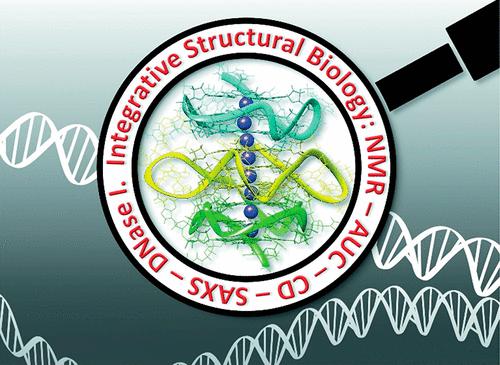当前位置:
X-MOL 学术
›
Acc. Chem. Res.
›
论文详情
Our official English website, www.x-mol.net, welcomes your
feedback! (Note: you will need to create a separate account there.)
G-quadruplex DNA: A Longer Story
Accounts of Chemical Research ( IF 16.4 ) Pub Date : 2022-10-25 , DOI: 10.1021/acs.accounts.2c00519 Robert C Monsen 1 , John O Trent 1, 2, 3 , Jonathan B Chaires 1, 2, 3
Accounts of Chemical Research ( IF 16.4 ) Pub Date : 2022-10-25 , DOI: 10.1021/acs.accounts.2c00519 Robert C Monsen 1 , John O Trent 1, 2, 3 , Jonathan B Chaires 1, 2, 3
Affiliation

|
G-quadruplexes (G4s) are distinctive four-stranded DNA or RNA structures found within cells that are thought to play functional roles in gene regulation and transcription, translation, recombination, and DNA damage/repair. While G4 structures can be uni-, bi-, or tetramolecular with respect to strands, folded unimolecular conformations are most significant in vivo. Unimolecular G4 can potentially form in sequences with runs of guanines interspersed with what will become loops in the folded structure: 5′GxLyGxLyGxLyGx, where x is typically 2–4 and y is highly variable. Such sequences are highly conserved and specifically located in genomes. In the folded structure, guanines from each run combine to form planar tetrads with four hydrogen-bonded guanine bases; these tetrads stack on one another to produce four strand segments aligned in specific parallel or antiparallel orientations, connected by the loop sequences. Three types of loops (lateral, diagonal, or “propeller”) have been identified. The stacked tetrads form a central cavity that features strong coordination sites for monovalent cations that stabilize the G4 structure, with potassium or sodium preferred. A single monomeric G4 typically forms from a sequence containing roughly 20–30 nucleotides. Such short sequences have been the primary focus of X-ray crystallographic or NMR studies that have produced high-resolution structures of a variety of monomeric G4 conformations. These structures are often used as the basis for drug design efforts to modulate G4 function.
中文翻译:

G-四链体 DNA:一个更长的故事
G-四链体 (G4s) 是在细胞内发现的独特的四链 DNA 或 RNA 结构,被认为在基因调控和转录、翻译、重组和 DNA 损伤/修复中发挥功能作用。虽然 G4 结构可以是单分子、双分子或四分子链,但折叠的单分子构象在体内最为重要。单分子 G4 可以潜在地形成序列,鸟嘌呤的运行散布在折叠结构中将成为环的东西:5′G x L y G x L y G x L y G x,其中x通常为 2–4 和y是高度可变的。这样的序列是高度保守的并且专门位于基因组中。在折叠结构中,每次运行的鸟嘌呤结合形成具有四个氢键鸟嘌呤碱基的平面四分体;这些四分体相互堆叠产生四个链段,以特定的平行或反平行方向排列,由环序列连接。已经确定了三种类型的环路(横向、对角线或“螺旋桨”)。堆叠的四分体形成一个中央空腔,该空腔具有用于稳定 G4 结构的单价阳离子的强配位点,钾或钠是首选。单个单体 G4 通常由包含大约 20-30 个核苷酸的序列形成。这种短序列一直是 X 射线晶体学或核磁共振研究的主要焦点,这些研究已经产生了各种单体 G4 构象的高分辨率结构。这些结构通常用作药物设计努力调节 G4 功能的基础。
更新日期:2022-10-25
中文翻译:

G-四链体 DNA:一个更长的故事
G-四链体 (G4s) 是在细胞内发现的独特的四链 DNA 或 RNA 结构,被认为在基因调控和转录、翻译、重组和 DNA 损伤/修复中发挥功能作用。虽然 G4 结构可以是单分子、双分子或四分子链,但折叠的单分子构象在体内最为重要。单分子 G4 可以潜在地形成序列,鸟嘌呤的运行散布在折叠结构中将成为环的东西:5′G x L y G x L y G x L y G x,其中x通常为 2–4 和y是高度可变的。这样的序列是高度保守的并且专门位于基因组中。在折叠结构中,每次运行的鸟嘌呤结合形成具有四个氢键鸟嘌呤碱基的平面四分体;这些四分体相互堆叠产生四个链段,以特定的平行或反平行方向排列,由环序列连接。已经确定了三种类型的环路(横向、对角线或“螺旋桨”)。堆叠的四分体形成一个中央空腔,该空腔具有用于稳定 G4 结构的单价阳离子的强配位点,钾或钠是首选。单个单体 G4 通常由包含大约 20-30 个核苷酸的序列形成。这种短序列一直是 X 射线晶体学或核磁共振研究的主要焦点,这些研究已经产生了各种单体 G4 构象的高分辨率结构。这些结构通常用作药物设计努力调节 G4 功能的基础。











































 京公网安备 11010802027423号
京公网安备 11010802027423号